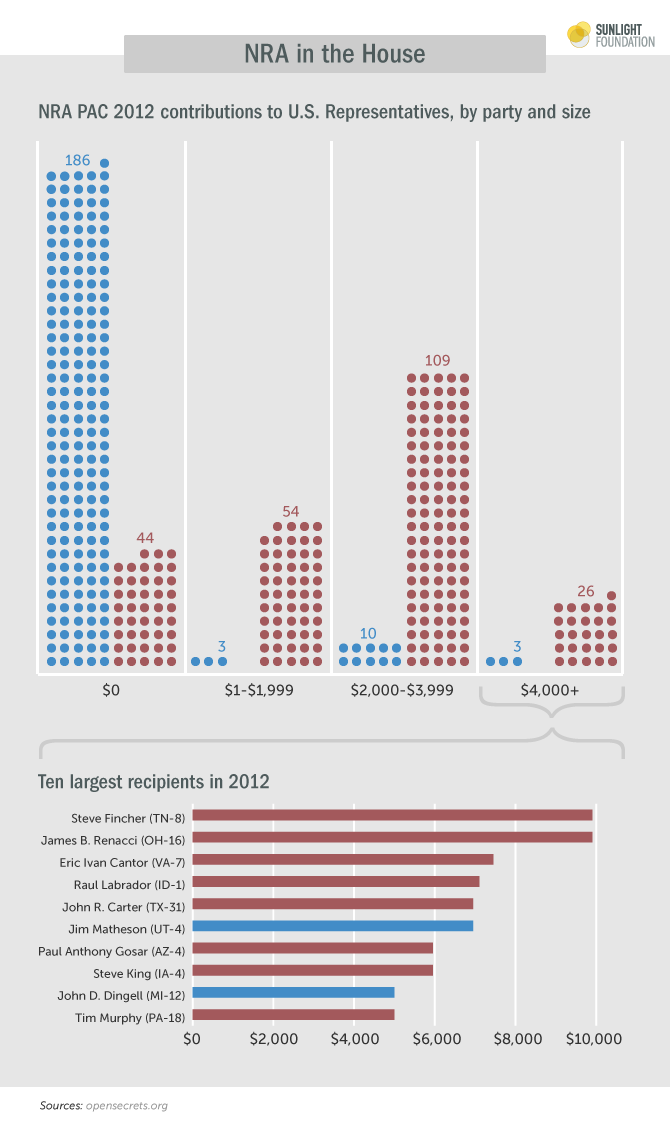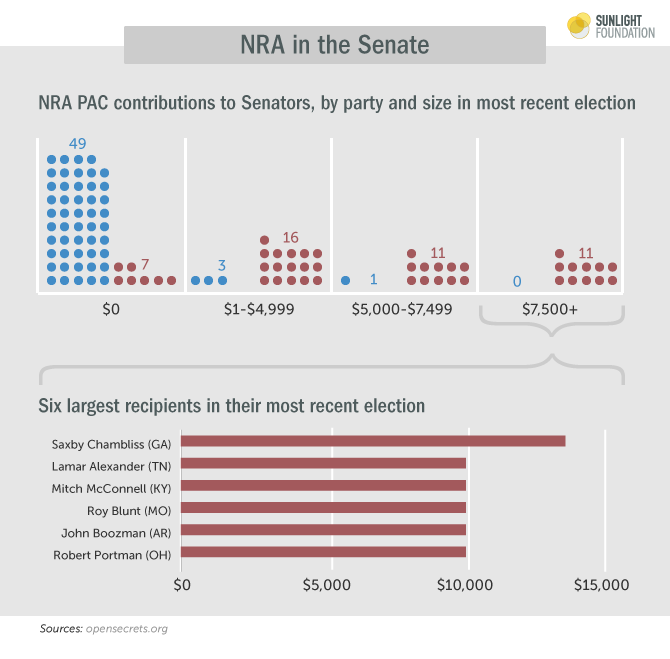NRA’s allegiances reach deep into Congress
This post was prepared in collaboration with Alexander Furnas and Amy Cesal
Just over half (51 percent) of the members of the new Congress that convenes next month have received funding from the National Rifle Association’s political action committee at some point in their political careers, an analysis by the Sunlight Foundation finds. And 47 percent received money from the NRA in the most recent race in which they ran.
The numbers give insight into the depth and breadth of support that the nation’s most powerful gun lobby commands. They also highlight the primary obstacle to quick action on gun control in response to last week’s massacre in Newtown, Conn. – deep and long-lasting allegiances to the National Rifle Association.


graphics by Amy Cesal
Of the 435 members of the new House, 205 – or 47 percent – received some money from the NRA during the last campaign. More than half have taken NRA money at some point in their career. Of the Senate’s 100 members, 42 received contributions this past cycle and exactly half have received contributions at some point in their career. All told, 88 percent of Republicans now in Congress have received a contribution from the NRA at some point in their career, as have 11 percent of Democrats.
The NRA’s beneficiaries include key players such as Senate Majority Leader Harry Reid, D-Nev., and Rep. Pete Sessions, R-Texas. Sessions, one of the NRA’s top recipients ($4,950 this cycle, $64,000 over his career), will serve as the chairman of the House Rules Committee next year, a post that puts him in a position to decide what legislation gets onto the House floor, and what does not. Reid received $4,950 from the NRA the last time he ran (2010), and has received $10,450 over his career.
In the House, the majority party can exercise near complete control over the legislative agenda, and that majority party next year will still be the Republicans – a party where the NRA has many friends. We find that 81 percent of the House Republican Conference (189 of 233 members) received some money from the NRA in their most recent campaigns, and 88 percent (204 of 233) have received NRA money at some point in their careers; Among House Democrats, 8 percent (16 of 201) received NRA money this cycle, and 10 percent (21 of 201) have ever received NRA money. For NRA contributions to House members, click here.
In the Senate, 84 percent of Republicans (38 of 45) received NRA money during their most recent election, and 93 percent (42 of 45) have received contributions at some point. Among Democrats, 8 percent (4 of 53) received contributions the last time they ran, and 15 percent (8 of 53) have received contributions at some point. For NRA contributions to Senators, click here.
It is important to note that these contributions are probably a better measure of allegiance than of influence. The average PAC contribution in the House was a mere $2,390, though the average contribution in the Senate was higher, at $6,067. Only 36 lawmakers received contributions of more than $5,000 – 13 in the House, and 23 in the Senate.
More than anything, these numbers help us to identify who the NRA considers its friends in Congress, and something about the closeness of those friendships.
It is also important to note that the vast majority of the NRA’s $18.6 million in political spending this past cycle went to independent expenditures, including $13.1 million into the presidential race. Additionally, the NRA spent $880,859 opposing Sherrod Brown (D-Ohio), $626,128 opposing Bill Nelson (D-Fla.), and $612,449 opposing Tim Kaine (D-Va.). These numbers tell us more about the closeness of the race than the intensity of the NRA’s preferences. All told, the NRA made independent expenditures either in support of or in opposition to 97 candidates this past election. (For our full list, see here) While the NRA’s spending this election failed to yield the desired outcomes, the group spends at levels that politicians both fear and crave, which gives it power.
The NRA also derives substantial influence from its membership base of more than four million members, many of whom look to the NRA voting scorecards as key inputs in their voting decisions. Half of 113th Senate gets at least an “A-“ rating from the NRA. In 2010, the NRA had a $243 million budget, dwarfing all other gun issue groups.
It’s also important to note that for decades, there have been practically no resources and pressures on the other side of the issue. Members know that opposition to gun control brings political rewards (the support of the NRA) while support of gun control brings only political liabilities (the opposition of the NRA). Without a group on the other side, the calculus for members is clear, and explains why the United States has among the most permissive gun ownership laws in the world.
But these data also show that the NRA’s influence is not absolute. A narrow majority of members in both the House and Senate have not received contributions from the NRA in their last race.
Thanks to Eric Mill and Alison Rowland for their help in preparing this post.
Data sources: Influenceexplorer.com and Opensecrets.org

